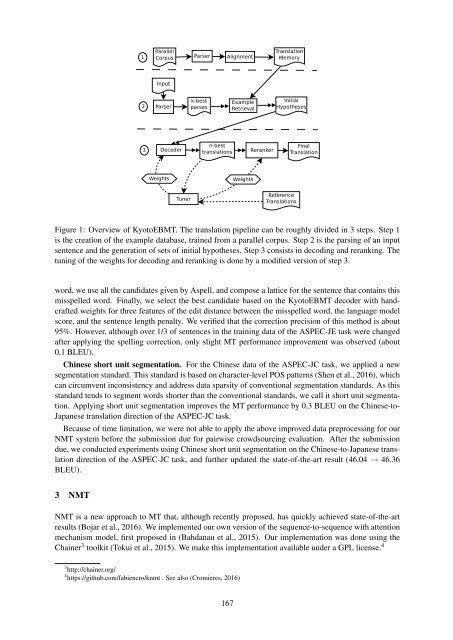December 11-16 2016 Osaka Japan
W16-46
W16-46
Create successful ePaper yourself
Turn your PDF publications into a flip-book with our unique Google optimized e-Paper software.
Figure 1: Overview of KyotoEBMT. The translation pipeline can be roughly divided in 3 steps. Step 1<br />
is the creation of the example database, trained from a parallel corpus. Step 2 is the parsing of an input<br />
sentence and the generation of sets of initial hypotheses. Step 3 consists in decoding and reranking. The<br />
tuning of the weights for decoding and reranking is done by a modified version of step 3.<br />
word, we use all the candidates given by Aspell, and compose a lattice for the sentence that contains this<br />
misspelled word. Finally, we select the best candidate based on the KyotoEBMT decoder with handcrafted<br />
weights for three features of the edit distance between the misspelled word, the language model<br />
score, and the sentence length penalty. We verified that the correction precision of this method is about<br />
95%. However, although over 1/3 of sentences in the training data of the ASPEC-JE task were changed<br />
after applying the spelling correction, only slight MT performance improvement was observed (about<br />
0.1 BLEU).<br />
Chinese short unit segmentation. For the Chinese data of the ASPEC-JC task, we applied a new<br />
segmentation standard. This standard is based on character-level POS patterns (Shen et al., 20<strong>16</strong>), which<br />
can circumvent inconsistency and address data sparsity of conventional segmentation standards. As this<br />
standard tends to segment words shorter than the conventional standards, we call it short unit segmentation.<br />
Applying short unit segmentation improves the MT performance by 0.3 BLEU on the Chinese-to-<br />
<strong>Japan</strong>ese translation direction of the ASPEC-JC task.<br />
Because of time limitation, we were not able to apply the above improved data preprocessing for our<br />
NMT system before the submission due for pairwise crowdsourcing evaluation. After the submission<br />
due, we conducted experiments using Chinese short unit segmentation on the Chinese-to-<strong>Japan</strong>ese translation<br />
direction of the ASPEC-JC task, and further updated the state-of-the-art result (46.04 → 46.36<br />
BLEU).<br />
3 NMT<br />
NMT is a new approach to MT that, although recently proposed, has quickly achieved state-of-the-art<br />
results (Bojar et al., 20<strong>16</strong>). We implemented our own version of the sequence-to-sequence with attention<br />
mechanism model, first proposed in (Bahdanau et al., 2015). Our implementation was done using the<br />
Chainer 3 toolkit (Tokui et al., 2015). We make this implementation available under a GPL license. 4<br />
3 http://chainer.org/<br />
4 https://github.com/fabiencro/knmt . See also (Cromieres, 20<strong>16</strong>)<br />
<strong>16</strong>7



